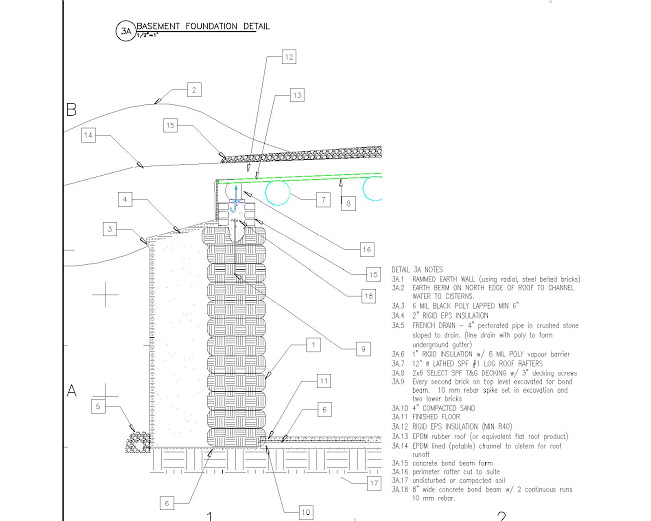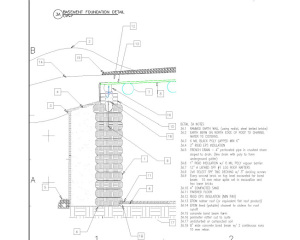
 This is a hot topic … people have been weighing in both for and against floor insulation by email and on the blog. In fact you might even say the discussion has been heated … alright I’m going to drop the puns from this point forward!
This is a hot topic … people have been weighing in both for and against floor insulation by email and on the blog. In fact you might even say the discussion has been heated … alright I’m going to drop the puns from this point forward!
As near as I can make out the basic earthship design has evolved somewhat since the publication of Michael Reynold’s third earthship book, and some of the newer design details do not seem to be readily available (unless I have missed them in my reading).
In his newer work Mike Reynolds refers to a thermal wrap around the earthship and it took a fair bit of digging (I can’t help it) to find out what this thermal wrap is. It turns out the thermal wrap is a layer of rigid insulation placed around the bermed walls of the earthship after an initial backfill of the walls has been done.
I am assuming the point of this thermal wrap is to increase the amount of insulated mass attached to the earthship, and consequently to increase the efficiency of the ‘thermal battery’ that is the basis of the earthship design.
I have upgraded my initial drawing and include a cross section view of this whole idea at the top of this article. I believe that this thermal wrap is supposed to address issues that the earthship design has had in colder climates, specifically that it did not retain enough heat during the winter, and thus was not successful in regulating its temperature. Also, I have read complaints that despite a given earthship staying warm enough during the winter months, the floor temperature was simply too cold.
So, on the one side of this argument is the original earthship concept. The basic premise of this argument is that the minimum temperature of the earthship should not dip lower than about 55 degrees F (stable earth temperature), and the warming action of the sun during the day should in fact keep that temperature in an acceptable range of 65-75 degrees F.
On the other side of the argument are the reported failures of the earthship design in cold weather climates. Reading between the lines I think the failure of the design stems from the ground under and to the north of the earthship still being affected by seasonal temperatures. In other words, the ground under the earthship settles out somewhere between stable earth temperature and a value above freezing. I suspect this failure is also tied to quality of winter sun in various regions. We live in a valley and I have some concerns about the amount of sun we get in December.
So where do I weigh in on this entire argument …
I have now been in an earthship in Ontario on December 20th (2nd shortest day of the year) and it was -20 degrees C outside. The inside temperature was about 65 degrees F and the only additional heat was provided by a wood cook stove when food was being cooked. The basic premise that the earthship should maintain a reasonable and consistent temperature was being met. The floor in this earthship was not insulated, and the builder agrees with Micheal Reynolds that the floor should NOT be insulated.
I have to admit, although not intolerable, I did find the floor cooler than I would have liked. I tend to agree with the basic statement that an uninsulated floor is going to be cooler than your desirable room temperature of say 20 degrees C simply because stable earth temperature is below this temperature. It seems to follow that in a colder winter climate the floor will be that much colder than desired room temperature.
I intend on having a backup heating system in my house. I am actually in favour of radiant heat as opposed to direct wood heat, and I would prefer a warm floor. It would be possible to run the radiant heat in the tire walls and/or the floor. I do not see any need to insulate or heat the floor under the planters and a few other locations. Beyond this I have not come to any conclusions.
Hi Canada!
I write from Sweden, northern Europe with same climate zone as parts of Canada. Well there is not any earthship raised yet here. I am to participate as volounteer next summer in mid county Värmland. I have checked the ground frost depth to be down to and even more than 79 inches there. That’s deep! As I understand the following pdf I see the depth in Darfield can be 50 inches. http://www.agf.gov.bc.ca/resmgmt/publist/500Series/590307-1.pdf
For Ontario, Bancroft, I used this map (page 5) to encount the depth. http://weather.nmsu.edu/News/nl-climate-spring-08_vg_comments.pdf It tells me 55″. At EarthShipSweden the disussion goes about a ‘new’ insulation made of old car windows. How far have you come to this query in Darfield? For me, 18°C (65°F) is to low inside. Hotwater pipes in my earthshipfloor it will be.
Sincerely, Ronny
Four feet is about the depth for frost depth in our area. Interestingly, I do not think we have had a winter recently (the last ten years) that has come close to that frost depth.
We intend to insulate the travelled portions of our floor … otherwise it will be too chilly for us!
Chris
My 2 cents. If the ambient temp of the earth envelope is 55F, then when the interior temp of the house is below 55F, the house will “take” heat from the earth until the temps are equalized. Similarly, if the house temp is greater than 55F, the process will reverse, with heat “leaked” into the earth. IMO, insulation would help to slow, if not stop, the leakage.
IMO, the energy efficiency of an earthship is that the ambient ground temp is a moderate 55F, and not the -20F or so of the air temp. I would certainly insulate, at least the floor, which is otherwise in direct contact with that 55F! (And I like radiant floor heat too!)
best of fortune with your very significant project!
You really wrapped yourself around this subject. I tried to understand the Mongolian situation. One mining info page suggested that the max frost depth here was 1.9 meters. Actually in the southern half of Mongolia that is probably true. I found other research which took soil temperatures at various depths. They had a map of Mongolia with various types of permafrost. Some places it’s discontinuous and spotty. Under UB generally there is permafrost at a depth of 5-15 meters at a temperature of around -0.2C. Below 15 meters it very gradually gets above freezing. Above the depth of 5 meters it is influenced by the seasonal temperature. So it’s not practical to dig deep below frost. We get lots of sun. What are the alternatives besides insulating maybe 2 tire courses under the ground with high load bearing expensive insulation?
The “thermal battery” concept is misleading. In New Mexico it is fairly warm underground. Yes, some heat may be stored nearby in the ground. If you’re on permafrost or near permafrost several meters under the ground, there’s no avoiding it. It will definitely suck heat out of your house. If you get under the max frost depth, it is above freezing, but might not be +58F immediately below that either. You might contain some heat in the thermal mass below the house, but more likely heat will transfer further down into cold earth below +58F further below.